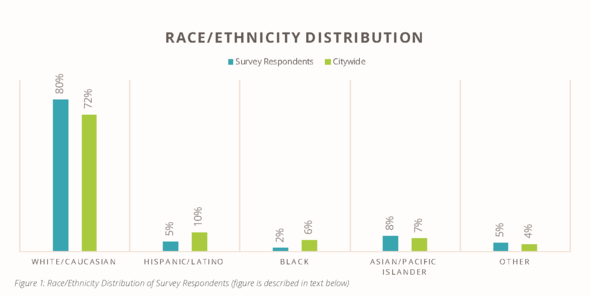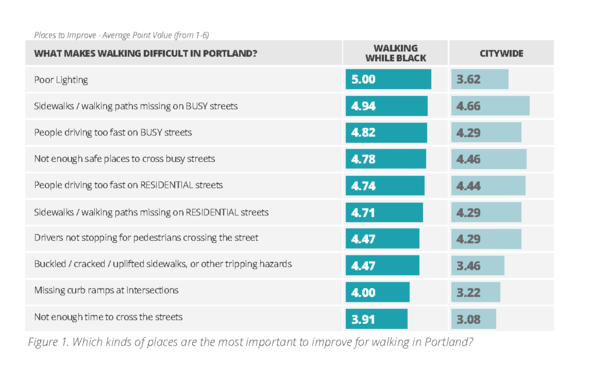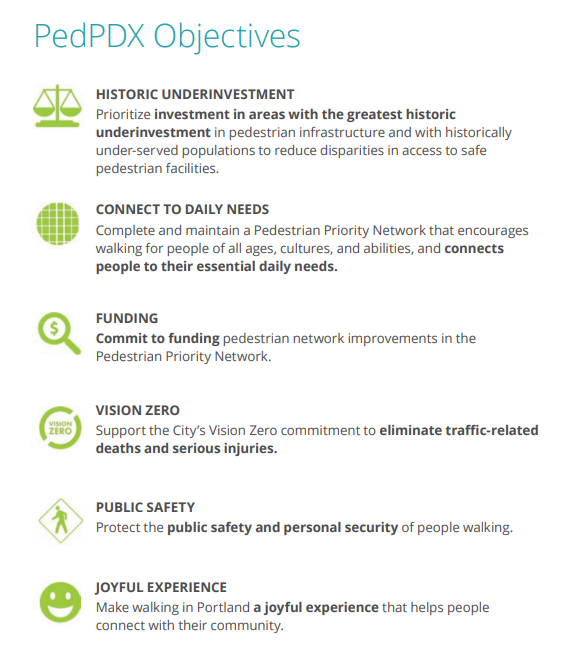
News media contact:
Hannah Schafer
(971) 235-8472

News Blog:
PedPDX: Walking While Black
PedPDX data analysis and public outreach finds that one’s experience walking in Portland depends a lot on where in the city you live or work, but it also depends upon who you are.
(March 12, 2019) The experience of walking in Portland depends a lot on where in the city you live or work. Portland’s neighborhoods closer to downtown tend to have a fairly well-developed pedestrian network, while Southwest and East Portland have significant gaps in sidewalks and crossings.
However, data and public outreach from our citywide pedestrian plan, known as PedPDX, tells us that the experience of being a pedestrian in Portland also depends on who you are.
In Portland, pedestrian safety and access is an equity issue. Inadequate pedestrian infrastructure and traffic safety concerns disproportionately impact low-income communities and people of color.
Comparing sidewalk presence (left) to PBOT’s Equity Matrix (right) shows that many Portland neighborhoods lacking sidewalks are also areas with higher equity concerns. The orange lines in the map at the left indicate where sidewalks exist in Portland. The darker orange areas in the map on the right show areas of the City where low-income and non-white populations are highest. The maps show that sidewalks are more often missing in neighborhoods with higher equity concerns, particularly in the outer neighborhoods of East Portland.

Because of this disproportionate impact on non-white populations, the PedPDX project team was intent upon making sure that we heard from all Portlanders as part of our planning process.
A key piece of the PedPDX public outreach strategy was a citywide “Walking Priorities Survey,” asking Portlanders to tell us what the biggest barriers to walking in Portland are, and where improvements are most important to community members. This feedback directly influenced the plan’s prioritization of new sidewalks and crossings, as well as the strategies and actions in the PedPDX “Implementation Toolkit.”
However, upon evaluating who we heard from in the survey, it became evident that we were not hearing from all Portlanders. Project staff compared survey responses to the racial and geographic distribution of the city’s population. Out of the 5,405 total respondents to the PedPDX Citywide Walking Priorities Survey, 2 percent identified as African or African-American. However they represent 5.7 percent of Portland’s overall population.

In recognition of the low recorded response rate from African and African-American Portlanders in the Walking Priorities Survey, the project team hosted two focus groups to more intentionally elevate the voice of Black Portlanders in PedPDX. PBOT staff worked with community partners from the Portland African American Leadership Forum (PAALF), Black Parent Initiative (BPI) and Immigrant and Refugee Community Organization (IRCO) Africa House to secure more input from the Black community and to better understand how their walking experience may be different because of their racial and ethnic identities. Facilitators provided a space for black Portlanders to speak candidly about their “Walking While Black” experience in Portland, which the feedback shows is different from other community members.
Barriers to Walking
Focus group participants were asked “what makes walking difficult in Portland?” Like the citywide survey, participants were asked to rank a variety of potential barriers on a scale from 1 to 6, with 1 indicating “not important” and 6 indicating “really important.” The table below shows the responses from Black Portlanders who attended the focus groups compared to data collected from citywide survey.
The most prominent difference was the importance of street lighting to Black Portlanders. Walking While Black focus group participants rated “poor lighting” as the biggest barrier to walking, with an average rating of 5.0, while it was ranked significantly lower than in the citywide survey responses.

Focus group participants highlighted the impact that dark streets have not only on traffic safety, but on personal safety and security in the public realm. Participants shared that they regularly make travel choices based on how safe and visible the route feels, and often choose travel options that are longer or more expensive as a result.
In addition to answering the two PedPDX survey questions, the facilitators wanted to capture more information about the unique experiences of the Black community to better understand their transportation concerns and barriers. During the focus groups, the 2017 MAX incident was elevated as having a lasting impact on feelings of safety in public spaces and during travel commutes. While participants acknowledged that this was an extreme event, many participants shared experiences they have had on public transit or in public spaces that made them feel exposed and vulnerable to racially-motivated attacks.
Community members shared the following concerns, experiences, and recommendations during the two focus groups:
Personal Safety
- “When you’re Black [anywhere in Portland], you have to make sure that you are extra careful when crossing the street or using the crosswalk.”
-
“Fear of getting in trouble for jaywalking, always feeling the extra pressure to follow the law and go to the right crossing, which can be hard to do. This is like having to keep your receipt on you when you go shopping because you might get stopped for no reason and have to prove yourself. Head coverings draw more attention, want to be doing the exact right thing, crossing in the right place.”
- “I won’t allow my husband to run at night as a tall Black man, for I fear he won’t come home.”
- “I pay a large amount of money for my son’s car insurance because it is safer for him to drive than to be exposed.”
- “I want to lose weight by walking but can’t walk after 5 pm because I am afraid to exercise when it gets dark. I feel vulnerable, so I stay home or drive and it is impacting my health.”
Encounters with Prejudice
- “The political climate has become more hostile for Black people. A Somali woman was crossing at a green light, people were yelling at her for no reason.”
- “Being the target of racial slurs when crossing the street. I press the button to get the green light, then someone yells racial slurs at me because they have a vehicle and don’t like that they were made to wait for me”.
Microaggressions in our Streets
- “White people not sharing the sidewalk, expecting Black people to step out of their way instead of moving right to make space mutually, respectfully.”
- “Crosswalk White girl magic - where cars stop for White women, not for Black people.”
- “I’m offended, saddened, and disappointed being a Black person walking in Portland.”
Making PedPDX responsive to Black Portlanders’ Concerns
As transportation planners and engineers, we often think about safety in terms of traffic safety (i.e., how can we prevent crashes and injuries on our streets?). However, the feedback we heard in our Walking While Black focus groups made us realize that if Portland is to be a great pedestrian city for all, we must also pay attention to community members’ sense of personal safety and security in the public realm.
In response to this feedback, one of PedPDX’s six objectives speaks to this need to protect the public safety and personal security of pedestrians.

The plan’s Implementation Toolbox includes several strategies and actions intended to help us meet this objective. Action 6.1 introduces new lighting-level guidelines that will increase lighting on public streets as new capital projects and private development goes in. Actions 12.1, 12.2, and 12.3 are intended to address issues of safety and security in the public right-of-way, reinforcing our commitment to equity and eliminating disparate outcomes due to race. In addition to increasing lighting in underserved communities, these actions include partnering with other agencies and city bureaus to advance the well-being and personal security of vulnerable communities, and continuing to research racial bias and driving behavior.
The full Implementation Toolbox and the Walking While Black Focus Group Summary appendix item is available on our project website at pedpdx.com.
This Friday, March 15, from 11:30 a.m. to 1:00 p.m., PBOT staff Michelle Marx and Francesca Patricolo will be speaking at the Portland State University Transportation Research and Education Center (TREC)’s Friday Transportation Seminar (PBOT Edition) on PedPDX: Addressing Equity through Citywide Pedestrian Planning. The talk will be held at the Karl Miller Center at PSU, 615 SW Harrison St., Room 465 or can be viewed live online. Register to watch the presentation online here.
Give us your thoughts on PedPDX!
The full draft plan, a video overview of the PedPDX public process, and an online survey asking for public feedback on the plan is available at pedpdx.com.
In addition, PedPDX is co-hosting several “View + Review Parties” with our community partners in the coming weeks. A video overview of the plan will be shown at the event and participants will have a chance to discuss the plan with bureau staff:
Tuesday, March 12, 6 - 7:30 p.m. at the Brentwood-Darlington Community Center
7211 SE 62nd Ave.
Portland, OR 97206
Thank you to our host, Brentwood-Darlington Neighborhood Association!
Complementary childcare provided at this event
Wednesday, March 13, 6 - 7:30 p.m. at the Rosewood Initiative
16126 SE Stark St.
Portland, OR 97233
Thank you to our hosts, Oregon Walks and The Rosewood Initiative!
Complementary childcare provided at this event. This event includes Spanish-language materials and interpretation.
PedPDX Fiesta para Ver y Revisar
Únase a nosotros para ver videos sobre PedPDX para conocer el contexto y el contenido del plan, disfrutar de algo de comida y contribuir con respuestas de encuestas para aprovechar su voz, necesidades y opiniones. Todos los asistentes recibirán un mosquetón de linterna PedPDX GRATIS!
Miércoles, 13 de marzo, 6 - 7: 30 p.m.
Rosewood Initiative
16126 SE Stark St.
Portland, OR 97233
En este evento se proporcionarán cuidado de niños, materiales en español y servicios de traducción. ¡Gracias a nuestros anfitriones, Oregon Walks y El Rosewood Initiative!
Wednesday, March 14, 6 - 7:30 p.m. at Hatch (Oregon Walks office)
2420 NE Sandy Blvd.
Portland, OR 97232
Thank you to our host, Oregon Walks!
Monday, March 18, 5:30 - 7 p.m. at the Multnomah Arts Center
7688 SW Capitol Highway
Portland, OR 97219
Thank you to our host, Southwest Neighborhoods Inc.!
Wednesday, March 20, 6 - 7:30 p.m. at Milepost 5
850 NE 81st Ave.
Portland, OR 97213
Thank you to our hosts, Oregon Walks, OPAL and APANO!
Thursday, April 4, 6 - 7:30 p.m. at the Native American Youth and Family Center (NAYA)
5135 NE Columbia Blvd.
Portland, OR 97218
Thank you to our hosts, NAYA!
Tuesday, April 9, 6 - 7:30 p.m. at the Historic Kenton Firehouse
8105 N Brandon Ave.
Portland, OR 97217
Thank you to our host, the North Portland Neighborhood Services (NPNS) Transportation Committee!
###
The Portland Bureau of Transportation (PBOT) is the steward of the City’s transportation system, and a community partner in shaping a livable city. We plan, build, manage and maintain an effective and safe transportation system that provides access and mobility. Learn more at www.portlandoregon.gov/transportation
|